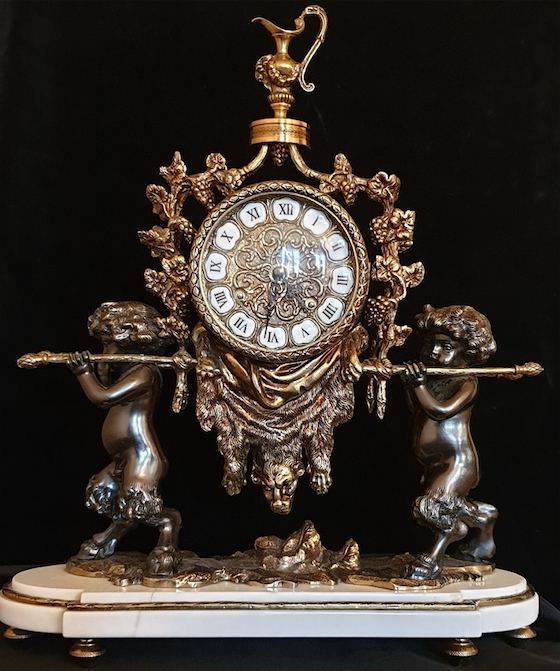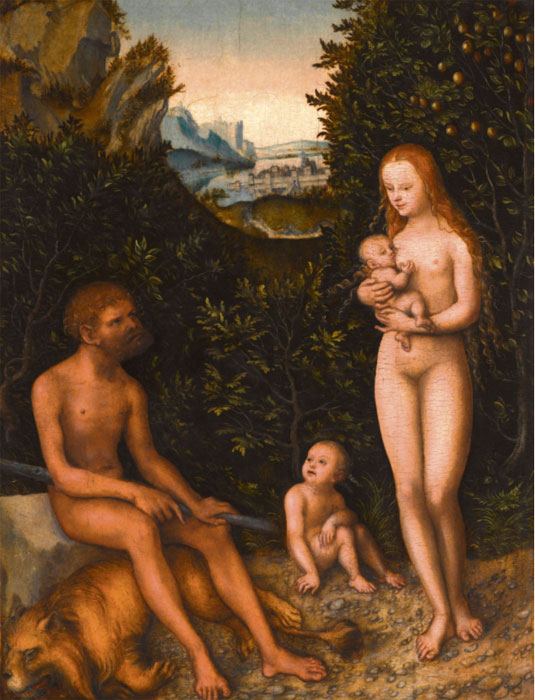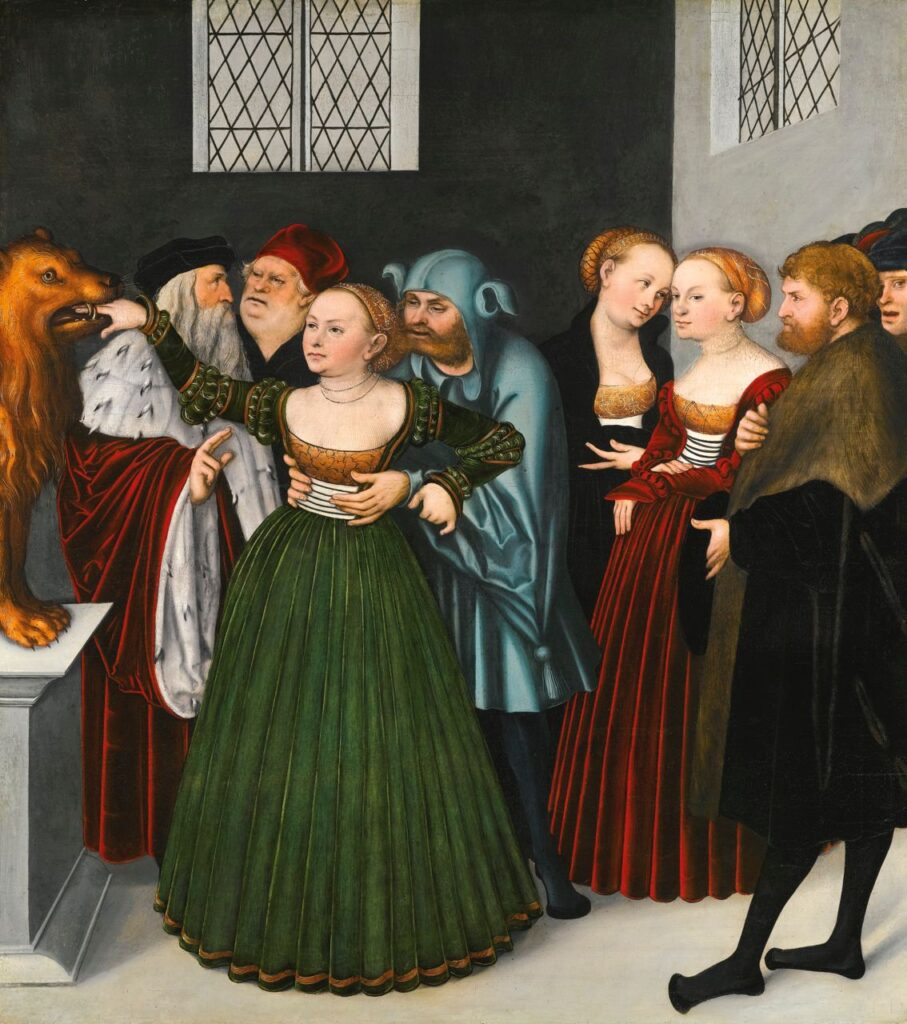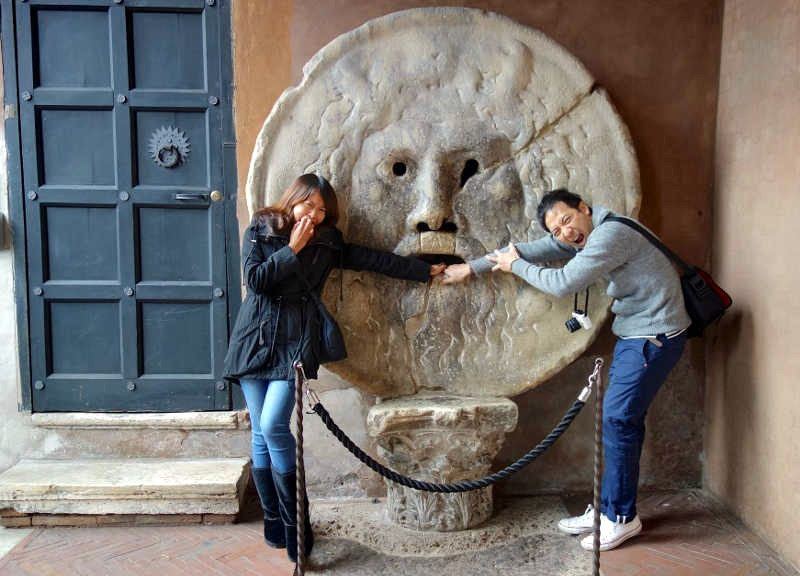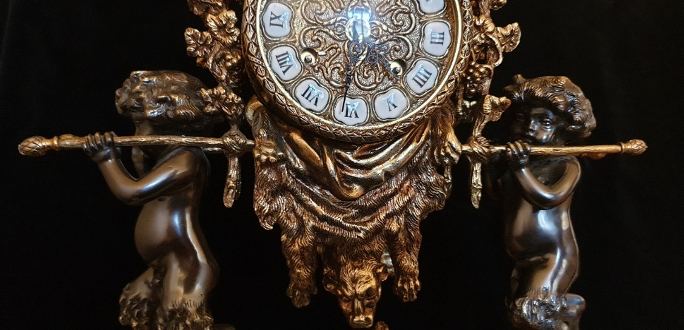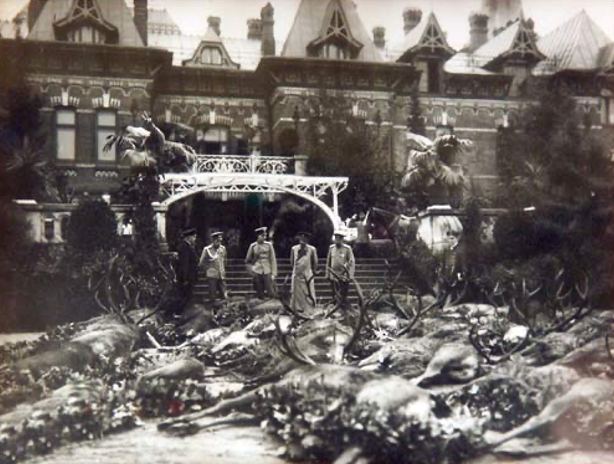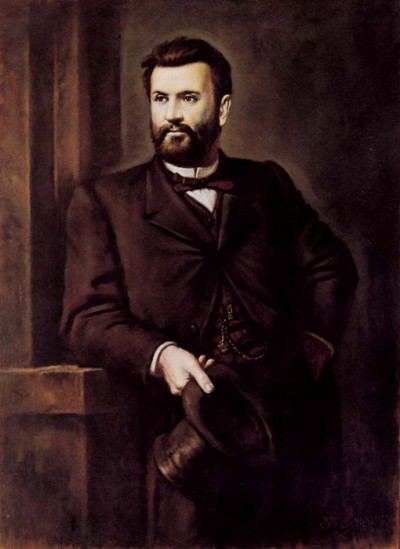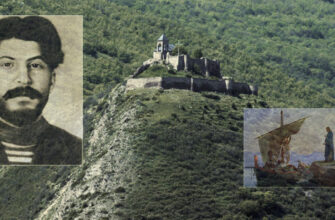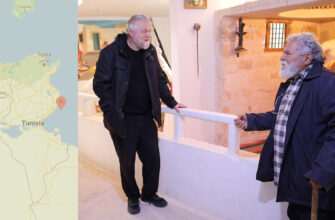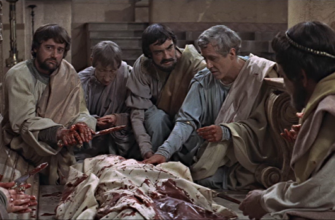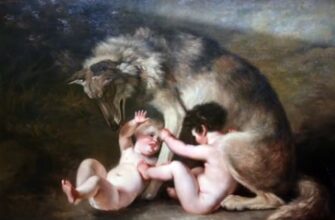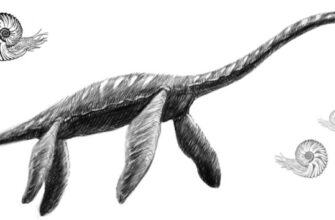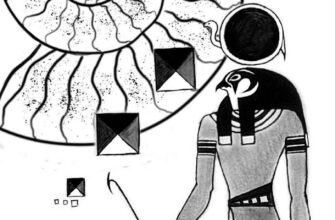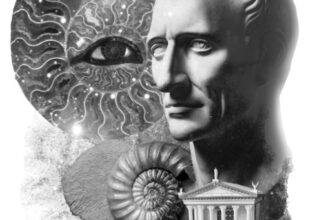Disclaimer: this chapter is translated by DeepL. The text will be updated after the translation has been corrected by a professional editor.
A study of the god Hephaestus can in no way be considered sufficiently complete without a comparative analysis of Hephaestus and the god Faun. But of course, I did not know that at first. Nowever, an amusing accident has corrected and guided me in a somewhat peculiar way.
It happened to me in Gori, Georgia, the town where Comrade Stalin was born, and where he has completed a large part of his path of initiation. The fact is, Gori is home to the ancient Temple of the Moon, the existence of which is not mentioned in any of Comrade Stalin’s biographies. And, at the same time, the real story of Comrade Stalin’s life starts with this ancient, if not prehistoric, temple.
It has been two years since me and my wife took refuge here after our successful escape from Russia. More precisely, it was an escape from the lawlessness of Russia’s so-called law enforcement agencies. You know, it’s hard to forget being tortured in prison. But the experience of prison turned out to be essential for understanding the cult of the Moon (Selene).
It’s hard to believe, but until that memorable day, which I want to tell you about, we had no idea there was an antique shop in Gori. Even though we have passed by this shop dozens of times we never realized what was there. I always thought it was a hardware store. The owners had some rubbish on display – like table lamps. I couldn’t imagine that those lamps were considered antique. I thought they were just an outdated inventory of a provincial hardware store. And that day, when I thought I was done with my research on Hephaestus (I mean the previous chapter), we decided to buy a table lamp, and we went to this store. Oh my God! We couldn’t believe our eyes! Almost immediately we stumbled upon a mantel clock and were shocked to see that it clearly belonged to some palace in the past.
It was impossible not to notice this clock against the background of tasteless objects. And there was only one family within walking distance from Gori, in which both spouses were of royal descent. They were the same Machabeli, whose house Comrade Stalin used to visit when he was a child. They have helped little Soso to get acquainted with the precious knowledge in works of Shakespeare, the knowledge associated with the Temple of the Moon as well. They have also helped him to learn how to develop practical skills for interpretation of mysterial theater.
But at the time we didn’t realize who were the previous owners of this mantelpiece clock with the little Fauns – it was merely the beauty of the item that struck us. And the price pleasantly surprised us, too. Even if this clock with the fauns were five times more expensive, we would have bought it anyway. But the price was unbelievably low. How could that be? Maybe no one wanted it, because they associated the hooves with the Devil. Well, for the average person only the hooves and the barrel of wine could have “made sense” in this strange composition. And the population of Gori is religious. Nearly everyone crosses themselves when passing by the church. I guess, it would not hurt them to learn the difference between deer and goat hooves, instead. The horns or antlers of the little fauns are barely distinguishable and one cannot tell if they are horns of a goat or antlers of a stag.
But never mind the population of Gori! I myself knew very little about the god Faun at the time. So I have also associated the stag hooves of the fauns with something satanic. But we’ve bought the clock anyway. I couldn’t care less about the hooves! And maybe there was another explanation of their meaning. So that’s how we got a powerful incentive to explore everything about the cult of the god Faunus being the opposite of the cult of Satan. The more so, since we have already touched on the topic of the Faun while discussing Julius Caesar, where the Faunalia is called the Lupercalia in the Russian translation.
Understandably, it was only later, at home, that we finally attempted to grasp the meaning of the composition around the clock. The main elements are two little fauns, holding on their shoulders what appears to be ceremonial staffs similar to thyrsi, and on top of the thyrsi there are two lioness skins. Then there is some small piece of cloth on top. And a barrel. And the barrel is surrounded by grape vines. Obviously, these are all symbols. The meaning of the vines and the barrel is quite clear. But, what does the combination of the fauns and lioness skins supposed to mean? As it turned out later, these could be the skins of male ancient cave lions which, unlike modern male lions, did not have manes, so they looked like lionesses.
I have searched for the counterparts of this clearly symbolic combination, and it turned out that this combination is nearly unique. The lion’s skin as a separate symbol is well known: there is one on the shoulders of Heracles, obtained by him, incidentally, in a cave, and another on the shoulders of “The One On His Knees”, a character from one of the constellations of the Star Chart. There have been continuous attempts to identify “The One On His Knees” with Hercules, precisely because of his lion skin, but they were never perfect. Perhaps “The One On His Knees” isn’t really Hercules at all.
But what about the combination of both a lion skin and a faun? Such a combination has been found only in a painting by Cranach the Elder, The Faun Family, 16th century, Germany.
Translated into modern language, it’s called The Lie Detector and How to Fool It. There was and still is a popular belief among religious people that if an unfaithful woman puts her hand into the mouth of a stuffed lion and lies under oath that she has not cheated, her hand will be bitten right off. The painting by Cranach the Elder depicts just such a scene, the testing of an obviously unfaithful and apparently deeply religious woman, who deceives the “lie detector” and to a certain degree everyone around. She approaches the stuffed lion and acts as if she genuinely believes a dead lion could bite her. She almost faints. She is about to collapse. Then someone dressed as a clown or a jester emerges from the crowd of bystanders and catches her, as she falls. At that moment, the woman swears that no one has ever touched her except her husband and this fool who is supporting her so she won’t fall down. And then she puts her hand in the dead lion’s mouth. The hand is left intact.
Of course, the clown is really her lover. So the lie detector, if it were able to bite, can be deceived – which is already something suspicious. And moreover, it allows to deceive everyone around and in the biggest possible way, because now they all believe that the gods themselves have revealed to them a model of an honest woman, and now in accordance with this model they will decide which of the wives or brides is honest and which is not. The cheated husband is on the right, a respectable-looking man, or a businessman in contemporary language.
So maybe this technique was not meant to expose unfaithful wives at all, but rather to fool the attendees in the biggest possible way? I wonder who invented this technique of ultimate deception?
Assuming that archaeological evidence can be trusted, this technique was invented by the god Triton. And Triton is the son of the darkest of the gods. First, his father is Poseidon, and second, his mother is Salacia, patroness of dockside prostitutes, the worst kind of whores. There are, of course, the palace whores too. However, textbooks authors apparently can’t tell the difference between dockside prostitutes and palace whores. Nor do they know the difference between success and luck. Too bad – this type of knowledge can be quite indispensable at times. Especially in spiritual matters.
Can you imagine what will become of a son of the likes of Poseidon and Salacia? And is it possible that such a champion of deception could somehow avoid supporting and encouraging cheating wives and brides?
The god Triton is depicted as having two whale tails instead of legs. It is often mentioned that these are actually dolphin tails, but it does not change anything: dolphins are evolutionarily related to whales. That is, for those familiar with sacred paleontology, everything is clear: Triton is associated with evolutionary degenerates who once came out of the water onto dry land only to return back into the water. The most obvious evidence for this transformation is that both the whales and dolphins have lungs instead of gills. And Triton is also depicted with a shell next to his lips. He is whistling. He is a whistler. And being a whistler is synonymous with being a liar in Russian language. And Triton is a record-breaking liar. He is the voice of the abyss.
Archaeological evidence of Triton’s character is as follows. There used to be a sewer system in Ancient Rome equipped with manholes for maintenance. And at least one of the manholes of the Roman sewers was covered with a flat marble statue 170 centimeters in diameter, depicting the god Triton with his mouth open. Simply put, it was a public toilet. There was an outgoing stench for the passersby and an incoming waste for the sewers. And that’s the actual way of life of Triton the Deceiver. But the crowd considers this statue of Triton to be “The Mouth of Truth”. Put your hand in Triton’s mouth and lie, and your hand will be bitten off. Such is the paradox of crowd perception. It’s the habit of being contrarians and a valuable object for contemplation.
But the choice of Triton’s statue for the sewer manhole cover is very logical: after all, the god Poseidon reigns not only over sea waters but also of sewage and fecal streams, which, of course, end up in the ocean. Who could better assist his father in collecting these streams than Triton?
A lot has changed over the centuries. This marble sewer manhole cover has been lifted and put upright. There is a steady stream of tourists, who come from all over the world to test their brides, wives and other partners for honesty. The tourists from Japan are the most zealous ones for some reason.
Translated into modern language, it’s called The Lie Detector and How to Fool It. There was and still is a popular belief among believers that if a dishonourable woman puts her hand into the mouth of a lion and falsely swears that she has not cheated, her hand will be bitten right off. The painting by Cranach the Elder depicts just such a scene as the test woman, herself an unfaithful wife, apparently of deep faith, deceives this lie detector, and by the same token, all those present. Here she approaches the stuffed lion and actively portrays how she believes an inanimate lion bites. She almost faints. Here she settles down. Then someone dressed as a clown or a jester strolls out of the crowd of onlookers and catches up with her, as she collapses. At that moment, the woman swears that no one has ever touched her, except her husband and this fool who is supporting her, so she won’t fall down. And puts her hand in her mouth. The hand is intact.
Of course, this clown is her lover. So the lie detector, if it is able to bite, allows itself to be deceived – which is already suggestive. And what is more, it allows to deceive everyone present, and in the strongest possible way, because now they all believe that the gods themselves have revealed to them a model of an honest woman, and now in accordance with this model they will decide which of the wives or brides is honest and which is not. The cheated husband is on the right, a respectable-looking businessman in our words.
Or maybe all this technology was not invented from the beginning to expose unfaithful wives, but rather to fool the attendees in the strongest possible way? I wonder who invented this technology of macho deception?
Assuming that archaeology provides exhaustive knowledge, this technology was invented by the god Triton. And Triton is the son of the darkest of the gods. Firstly, Poseidon, and secondly, his wife Salacia, patroness of port whores, of all whores the farthest. There are, of course, the palace ones. However, the guidebook writers apparently don’t know the difference between the port whores and the palace whores. Nor do they know the difference between luck and fortune. And in vain: sometimes it is very important knowledge. Especially in priestly matters.
Can you imagine what a son of the likes of Poseidon and Salacia will inevitably grow up to be? And can the champion of deceit Triton not cheer for cheating wives and brides?
The god Triton is depicted as having whale tails instead of legs. It is often written that they are dolphin tails, but it does not change anything: dolphins are evolutionary relatives of whales. That is, for those familiar with priestly paleontology, everything is clear: Triton is associated with evolutionary degenerates who once came out of the water element onto dry land, and then returned back into the water. This transformation is evidenced by the fact that instead of gills, they have lungs. And Triton is also depicted with a shell against his lips. A whistler. A whistler. And a whistler is known to be a liar. A record-breaker at that. The voice of the abyss.
Archaeological evidence of Triton’s essence is as follows. In ancient Rome, there was a sewer system. Manholes were provided for its maintenance. At least one of the manholes in Rome was covered with a flat marble statue 170 centimetres in diameter, depicting the god Triton with his mouth open. Simply put, a public toilet. There was a stench towards passers-by and a bad one towards the sewers. Such is Triton’s deceptive way of life really. But the crowd thinks this statue of Triton is “The jaws of truth”. Put your hand in Triton’s mouth and lie, and your hand will be bitten off. The paradox of crowd perception. The contrary. A valuable object of reflection.
But the choice of plot for the sewer manhole is very logical: after all the god Poseidon is the lord not only of sea waters but also of sewage and fecal streams, which, of course, end up in the ocean. Who better than his son Triton to assist his father in collecting these streams?
A lot has changed over the centuries. This marble sewer manhole cover has been lifted and put upright. Tourists now go to it – in a steady stream. Tourists who come from the other side of the world to test their brides, wives and others for honesty. The tourists from Japan are very zealous. For some reason, they are from Japan.
Triton is no doubt the most suitable god for checking the honesty of brides and wives. Indeed, after the sewer manhole cover doesn’t bite his wife or bride’s hand off, the husband or groom will learn the precise coordinate system of human society. His wife or bride will now become the reference point, the gold standard for honesty. And the opposite of the wife, such as Athena, will be perceived, on the contrary, as epitome of dishonesty. From now on, the deceived man will evaluate everything and everyone through this frame of reference. And he will evaluate the “clowns”, like the one from the painting by Cranach the Elder, among others.
It is clear that with such a worldview the deceived one cannot possibly make it to the heights through the Portal which the Faun arranged for himself and those who believe in him. The purpose of the Faun’s Portal is to let through from the previous layers of the world only those who in their hearts at least partially renounced their contrarian traits. It’s useless for the deceived (and the symbol of deceit and contrariety is a lack of aversion to goats) to just be physically present at the Lupercalia. Such a goat lover will continue to be a grassroots sheep at best. That is, he will not be able to reflect on the spiritual meaning of the Lupercalia, which is the inaugural mysteries, and therefore the most important ones. Just as neither the compilers of the reference books nor their readers have been able to reflect. And those, whom the priests of the Faun defined as the ultimate “goats” and appointed them during the Faunalia/Lupercalia to play their respective roles naked, will seem to the crowd as, ha-ha, “enlightened” near the sewer manhole, that is, at the latrine. Some sort of priests to be believed and obeyed.
Cranach the Elder went down in art history because he chose unconventional subjects for his paintings. One of his two paintings of lions has just such an unconventional subject. Invention is rare, it’s an ability of Priests. Simply put, Cranach the Elder is a Priest of the College of Kaa. The painting The Jaws of Truth, just like the sewer manhole cover, symbolizes the endlessly reproducing deadlock in our lives, toward which grooms and husbands are heading. And they are taking along their women, for whom they are theoretically responsible.
It would have been strange if Cranach the Elder, mind you, Martin Luther’s personal friend and teacher, had not developed an original idea for a painting, which would have shown a way out of this deadlock. Something to make it easier for a follower of the Faun to approach the Portal. And this is exactly what Cranach’s most expensive painting, The Faun Family, is. There is no Faun in the painting. Instead, there is a man understandably without horns or hooves. There’s his wife, too. She looks very innocent. And what I mean, is that she just appears to be very innocent. And then there are two of her children. Judging by the exaggerated expression of innocence the wife has assumed, the child she is holding is not her husband’s. Or maybe both children aren’t his. There is also a slaughtered lion at the man’s feet. The man looks at his wife with a frown and he seems to be overcome with grave suspicions. And so, what is the connection between the heavy thoughts of the hoofless “faun” and the dead lion, which the “faun” apparently has killed?
Given that only two of Cranach’s paintings feature lions, and Cranach the Elder was not interested in genre painting but in symbols (and very powerful symbols too), we can assume that in The Faun Family the lion is also a lie detector. The natural lion indeed has the features of a lie detector. Let’s say, a lion appears in front of a traveler ready to attack. If the traveler will not get rid of his delusions and will continue to be a contrarian, he will not think rationally and his contact with the lion will be fatal. But if in the face of death the traveler is able to get it together, to repent and to call things by their proper names – then he will survive.
But in The Faun Family the lion is killed and can no longer assist anybody in calling things by their proper names. In a figurative sense, the lion can no longer give the lying woman an impression that there is a real threat of losing her hand. In other words, this lie detector is broken. Moreover, it was broken by the hoofless man himself. So then why is he staring at his wife with suspicion? Isn’t he thinking, “Why in the world would I destroy a lie detector with my own hands? Who could be interested in what I’ve done? How could it possibly be in my interest? But then, why was it me who did the killing? Am I somebody’s puppet? But whose puppet am I?.. And so, the painting could be called A Puppet Learning To Think.
Of course, it is difficult to imagine that the man in the painting could have come to such thoughts on his own, without any access to Collective Mind. But maybe, after killing the lion, the man had a conversation with someone in the forest and learned something? Suppose, it was a conversation with the Faun. With the real, original Faun, the one that has stag legs and stag antlers. In that case, the order of events becomes clear. First, the man, who was not yet a faun (with a lowercase letter), killed a lion, then in the woods he picked up some thoughts from the real Faun, and became essentially a faun himself. He became a spiritual son of the Faun. Hence the title of the painting: The Faun Family.
The Faun family is not a lady with someone else’s child in her arms, but this man who is starting to think. In that case, the Faun is the father of thought. No reference book offers such a definition of the Faun. But the painting of Cranach the Elder does.
So now the “son” of the Faun sits next to the lion he has killed and wonders: what exactly just happened to him? And some strange words come to his mind: the Lupercalia, a portal, sacred paleontology…
The passage through the Portal of the Faun (with abandoned fishing nets and someone’s trident left on the steps leading to it) begins when you stop being a puppet of your puppeteer and start working for the sacred chain of “Teachers-Disciples”. In the limit, this would be a Mutational Group. As a consequence, you accept your wife as a potentially spiritual being and your possible ally. And you accept her children as well. And to make sure the children are able to think too, you need to reveal to them the secret about the neighbor being their real father.
Why do they all need these unpleasant discoveries? Well, all these discoveries are unpleasant only from the ordinary point of view, and not from the perspective of a priest. Isn’t it the right thing to do: to help at least your children? Even if it’s not done in the first place, they will eventually get help too. This is the way the world works: you may help your children only by joining the World of Teachers. Only when you work for yourself as a part of an entire paleontological species. There are methods of the Priests for this kind of work, which differ from the ones found in everyday life, and the first step in their technique is a meeting with the Faun and a development of respectful attitude toward him.
Well, what happens next depends on who is more spiritually mature in the family shown by Cranach the Elder. If the man is more mature, then he should be a teacher to the woman. She should assist him and not vice versa. The man assists the Faun, the woman assists the man, and the children assist the woman, but all of them together ultimately assist the Faun and Mutational Group. And let them work out for themselves which one of the gods is in charge on life’s journey. Let them remember Shakespeare and his Julius Caesar.
By the way, getting ahead of ourselves: one can’t pass through the next portal, the Portal of Hecate, without the involvement of a woman, and it has to be an honest woman too. So the man in the picture has a lot to consider.
There’s no shame in being of assistance to the Faun. Julius Caesar himself used to assist this god during the Lupercalia described in Julius Caesar. This assistance simply hasn’t been explicitly mentioned in the text of the play. The Lupercalia is described as naked Antony running around with a whip – that’s all. Nowadays, it’s a real challenge for the actor playing Caesar to be able to play Caesar’s assistance to the Faun. The actor’s performance must have a great depth. In order to achieve this, both actor and director could benefit from understanding the allegorical meaning of what is depicted in our mantlepiece clock. Especially the meaning of the cave lion skins.
So let’s get back to this serendipitously discovered mantelpiece clock featuring such a rare allegory. The question is, who would have wished to have this particular composition in their home so much that they were willing to pay for it? This is why this allegory is so rare – for ordinary people its meaning is obscure and, therefore, frightening. And it is obscure because it’s directly linked to the forgotten Faun’s Portal.
All people, without exception, walk through life carrying the weight of their imaginary victories. People claim these imaginary victories for self aggrandizement and self delusion. A person spits over the fence on the neighbor’s lawn and imagines himself or herself to be a rising warrior. Or someone secretly snatches some greens from the neighbor’s vegetable garden, like a literal goat, and imagines himself or herself to be a great housekeeper. This type of self aggrandizement is very similar to the way literal goats think.
“The burden of imaginary victories” is a sophisticated synonym of the word “goat”. True victories such as the vine and the measuring jug, as a symbol of moderation in the corresponding activities, cannot have too much weight on the shoulders of the little fauns. But imaginary victories can, and very much so. Here’s the question: do the little fauns carry all this symbolic rubbish home or to the trash? And more generally speaking: is it valuables or rubbish?
Well, it’s more likely the little fauns are heading to the trash, since the horizontal position of the thyrsi is very strange and not quite reverent.
In that case, the lion’s skin on its own symbolizes a break with the principle of calling things by their proper names. It symbolizes the break with the truth, i.e. with the World of Priests. But if these very skins are carried to the trash along with the symbols of alcoholism and delirium, all of which are related to the World of Dionysus (it’s the Word of the Tortoise in the diagram), then all this together symbolizes the true adoption of the little fauns by the Faun. That explains the little fauns’ antlers, which have only just begun to emerge and aren’t large or branched: the little fauns have only just passed through or begun to pass through the Portal of the Faun. Or they are still on their way to that portal.
In any case, that mantlepiece clock certainly helped me figure out the meaning of the Lupercalia from Julius Caesar. And thinking about the meaning of the Lupercalia/Faunalia leads to the hypothetical Portal of the Faun. And maybe the clock helped its previous owners to get there as well? If so, more people may also benefit from the allegory if they wish to understand Shakespeare’s Julius Caesar, and to understand Julius Caesar himself, too. And if they wish to understand Shakespeare.
So, whose house could these bronze “fauns” inhabit before? If you don’t count the Machabelli family? About 62 km from the antique store in Gori, in the village of Borjomi, there are two summer palaces of the Romanovs, the Russian royal family. There used to be a third palace, but it burned down. The fire happened during Soviet rule. Some things from inside the palace were taken out of the fire. It is not known whether or not all of these things that were saved ended up in the local museum, but it is hard to believe that no one snached anything away. Could our mantelpiece clock have been in the possession of the Romanovs before? Of course, the Romanovs are not the right kind of people, they lack qualities necessary to contemplate such things. Still, there is an opportunity for sacrilege. After all, they are nothing but empowered losers. And besides that, they represent everything else from the entire World of Poseidon (in the diagram – it’s the Bottom). We shall now see that the Romanovs are psychological cannibals.
In nearby Borjomi, where these palaces are located, the Romanovs entertained themselves by slaughtering stags. There are an impressive number of photographs with piles of killed stags, so many that it was clearly impossible to use them for food. It suggests that while killing stag after stag, the Romanovs imagined they were killing the Faun or the little fauns.
It is a permissible thought, because a faun is distinguished by his antlers and hooves, the rest of his body parts or the contents of his head are not taken into account. So a stag is the closest visual representation of a faun. According to all the details, including the dragon tattoo on Nicholas II’s arm, the Romanovs belong to the Bottom, to the element of Poseidon. Not only this type of people hate the inhabitants of the World of Priesthood, but they also hate those of the World of the Faun, i.e. the working people. They hate people doing all kinds of work, from the real astrophysicists to those who are involved in the most mundane jobs. And so, this hatred manifests itself in hating stags too. The Romanovs have mercilessly massacred them. Interestingly, the most active phase of stag killings occurred when Comrade Stalin was already born and lived only 62 kilometers from the place of this massacre.
So every time future Comrade Stalin, Soso, would see a depiction of the Faun and little fauns, he could not help but recall recurrect massacres in Borjomi that were carried out by the tsars of the Romanov dynasty in their lands near Gori.
But there is a detail that young Soso may not have known as a child. The fact is, there was another Romanov family estate about 60 km from Voronezh, where they held ritual killings of wolves at nights. Wolves were brought in cages from around the Russian Empire. And the ritual of killing was carried out in the oak grove, which bordered the castle or palace – I am not sure what to call this gloomy structure. After all these rituals the locals are afraid to collect firewood in the grove to this day. People do need firewood, but nobody collects it in the grove, which is surrounded by houses.
When I went there to inspect this property, the building was not quite abandoned but locked up tight. However, the oak grove was unfenced and accessible. Back then I was nearly 20 years younger and much more reckless about my health, so I decided to spend the night in that grove. Who knows, maybe I would see a vision or have an interesting dream there. So I put up the tent, and in the morning I could barely crawl out of it – I was feeling so bad, one could probably call such a condition the threshold of death. Could that be that the Romanovs have tortured the wolves before killing them? I had no dreams that night, and I saw no spirits, no ghosts, there was only this feeling of being on the brink of death.
But what if the killing of stags in Borjomi was also a ritual? After all, wolves and deer constitute something like a single whole – and not only in the natural world. Well, many people know this fact about nature: wolves purge deer herds from sick animals with necrobacteriosis hoof disease. From those who are lame just like Hephaestus. When a deer gets necrobacteriosis, the joint next to the hoof swells up. It’s a kind of gout, only in deer. It is very possible that in other languages the necrobacteriosis is called gout. And maybe the disease itself was passed to humans from deer.
Gout in humans is definitely a psychosomatic disease. It is cured by reflective thinking. And maybe it is psychosomatic in deer as well? If so, then a sick deer is a traitor. And wolves do not hunt healthy deer, even though they could easily catch up with them and kill them. The entire deer population thrives thanks to the wolves eliminating the sick ones and keeping the healthy ones safe.
Wolves get along just fine with shepherds. At least, with some of them. The wolves require a shepherd to have a certain quality: he must be morally healthy. That is, he must be a full-fledged participant of the Lupercalia. But, again, such compatibility takes place not just in nature. The sacred Lupercal cave at the foot of Palatine hill, in which the Lupercalian mysteries were set to begin, comes immediately to mind. Initially, there were three categories of inhabitants in the cave: the she-wolf, the Faun and their foster children, the founders, as it were, geniuses. The combination of the wolf and the stag has produced geniuses. More precisely, a subtle understanding of the relationship between wolves and stags, an understanding of how and why wolves protect stags from goats and dogs, an understanding of the secrets of goats and the basic sources of their power was the foundation upon which the speed of human thought has multiplied manifold.
If the Romanovs wanted to obtain the secret knowledge that can be acquired in the process of studying the Lupercalia, then (according to the logic of cannibals) instead of entering into a proper teacher-disciple relationship, they needed to devour or at least partake of the blood of the three basic elements: the deer, the wolves and the founders. Then the seemingly excessive number of slaughtered stags in Borjomi becomes comprehensible: they needed blood from as many stags as possible. Just a little bit of blood of each and every killed stag for the “communion”. And similarly, they would partake of the flesh and blood of each and every sacrificed wolf.
The idea of the importance of the Roman cave of Lupercal and its inhabitants may have come to the Romanovs as if it was somehow “smuggled” in. Because of the family name. For it’s very natural to suppose that the name “Romanovs” comes from the word “Roma”, i.e. Rome. So one can easily assume that Third Rome, that is Muscovy, is ruled by the descendants (even if secretly) of the founders of the original Rome, that is, they are the people from the Lupercal cave. There it is, dazzling greatness! And the rest is simple for the cannibals: if you want to boost this feeling of greatness in yourself, all you have to do is to eat all the inhabitants of Lupercal.
Which leaves us with the third element of the Lupercal Trinity – the founders. How to partake of their flesh and blood if the victims are human? I mean, if by the ancient definition, they are “two-legged animals without feathers and with broad, flat nails”? If the people of their country would find out about the cannibalism, the Romanovs would be trampled to death or shot somewhere in the Siberian town of Tobolsk.
According to the logic of cannibals, it is not actually necessary to eat the meat of the founders. It is enough to poison their biological life somehow. Or to kill them. Killing is part of the cannibal ritual. It is not necessary to hang the founders, you can send them to prison or into exile, while they are sick with tuberculosis. They’ll die there anyways, as they say. Send them, just like comrade Stalin, while suffering from tuberculosis, was sent to Kureyka on Yenisei river, which flows into the Arctic Ocean. And in fact, that is exactly what the Russian so-called law enforcement officers were doing, sycophantically fulfilling the cannibalistic wishes of the Romanovs! Hundreds of thousands, if not millions, were repressed, hanged or exiled to Siberia and the Arctic. Comrade Stalin was one of these very founders. The wolves and the stags were probably of particular interest to Stalin’s subconscious – at least because of the similarities of fate.
Comrade Stalin has built a hunting tent in Kureyka, just in the path of seasonal deer migration. Did he intend to hunt them? Or maybe to watch them? To observe them and their relationship with wolves.
As for wolves, Bolshakov has mentioned in his memoirs that once, while watching a movie in the Kremlin, Comrade Stalin surprised him, Bolshakov, by saying that wolves have green eyes. In fact, the wolf’s eyes are usually beige, and you can confirm this by visiting the zoo. Wolves’ eyes turn green only when a wolf makes contact with someone who he, the wolf, likes very, very much. So it turns out that all the wolves met by Stalin in the Arctic region had green eyes! However, I have a whole book written about wolves, and its title is taken from Kipling’s Mowgli (Jungle Book), when the leader of the wolf pack, the wise Akela, proclaims at Council Rock: “Look well, O Wolves!”
In order to expose the Romanov Tsars, one must keep in mind that they were not engaged in harassment of the founders per se, but only as long as they were part of the Trinity. By literally and symbolically devouring all the elements of the Trinity from the Lupercal cave, the Romanovs tried to master the basis of the ancient priests’ knowledge being guided by the logic of cannibals. It’s important, because the failure to identify the real motivation behind what is happening inevitably leads to the activation of the emotional indicator “pity”. Those who know nothing about indicators and psychosomatics will explain their feeling of pity by saying that the one they feel sorry for is suffering and therefore deserves their compassion. And they, as it turns out, have delicate, beautiful souls, so they have no choice but to be compassionate. But in reality the object of pity lies and conceals the motive of his activity. And in the subconsciousness of the observer an indicator is switched on, as a helpful hint to avoid being fooled. But the Rams, having one Goat in their heart and another in their lead, love to be fooled.
And indeed, if we remember 1905 and the years before it and after, we find, in addition to the mass executions by the order of the Tsar, a huge number of best people being innocently persecuted – and yet many still feel pity for Nicholas II the Bloody. They even canonized him as a Great Martyr. And all because they feel sorry for him not understanding this bloodsucker’s real motivations for his actions.
The Romanovs used to perform parts of the same ritual at different locations to hide the true meaning of their activities. They used to kill wolves in the Voronezh region of Russia, and to slaughter stags in Borjomi, in the Caucasus. Founders were hanged in all the countries subjugated by the Russian Empire. And finally, there were political exiles to Siberia and the Arctic. Did the Romanovs really think there was no force that could bring all the elements of this puzzle together? If one is willing to believe this nonsense about the World of Priests being powerless, one also has to believe that the actors, with whom Hamlet has clearly traveled before, were merely hired by someone – for some sycophantic purpose.
But there is sufficient power in us, the human population, which must and can grow in the next mutation. And it is a power of the kind that neither cannibals nor their servants possess. There may be more complex versions of mutual assistance than the one described in this chapter. And nothing would change, even if it were suddenly revealed that the mantel clock in question was made in the mid-20th century and is a copy of a certain Louis XVI-style model from the late 18th century. It would change nothing, except that another stage would be added to the description. But, essentially, nothing will change. Because the portal of the Faun, which opens new possibilities, will still remain. And there will be three types of reactions to this portal. First, the reaction of cannibals from the World of Poseidon. Second, the reaction of the hard-working, cheated husbands from the Middle World of the Faun. And third, the reaction of would-be Priests from the World of Athena.
In the past 150 years, only two prominent Shakespeareans used to dwell closer to that antique shop than Romanov Palaces: Ivane Machabeli, Grand Duke, that is, of royal lineage with his wife of royal lineage Barathioni, and the future Commissar of Defence Soso Dzhugashvili.
Ivane Machabeli has translated eight out of Shakespeare’s thirty six plays into Georgian. Julius Caesar is among them. I wonder which came first – the egg or the chicken? Did Ivane Machabeli first undertake a non-commercial translation of Julius Caesar, and only then did a mantelpiece with little fauns, thyrsi, wine vessels and cave lion skins appear in his house? Or, vice versa, first there was a composition, reflection on which led to an understanding of the mysteries of the Faun, and only then did work on the translation of Julius Caesar begin? A quality translation requires reflection on all the possible meanings of each word in the original text.
The technology of art reproduction was something new in the times of Machabeli, so it’s unlikely that Machabeli got acquainted with the paintings of Cranach the Elder by seeing their reproductions. But Ivane Machabelli traveled extensively around Europe, and being an offspring of a royal family, and having a wife, who was also of royal descent, he probably had access to the palaces. And there he could have the opportunity to meditate on the meaning of the subjects of Cranach the Elder’s paintings.
And then there’s another explanation. Couldn’t this clock be given as a gift to Machabelli when he was visiting some palace in Europe? The composition is very rare, who could want it other than scholars of ancient victorious worldview and Shakespeare? The hooves alone will scare away everyone else.
And another detail. Strikingly, this mantelpiece clock does not bear the mark of a craftsman. If a piece of such high craftsmanship was intended for sale, there would be a mark with the name of the craftsman. But there isn’t.
So, maybe Ivane Machabeli was either alone or with his wife in a palace somewhere in Europe or Asia Minor and someone used A Faun and His Family and the mantelpiece clock with fauns and lion skins to explain to him the meaning of the Lupercalia. At the same time they were also contemplating Shakespeare’s works. Say, why in Julius Caesar the Chief High Priest and writer Julius Caesar, of all the possible mysteries, draws the attention of his wife and the future generations particularly to the Lupercalia?
And then, in exactly the same way, but with Soso Dzhugashvili and without the original painting by Cranach the Elder, another educational process resembling ancient mysteries took place. And the Grand Duke Machabeli, in his turn, was explaining to Soso what’s what in Shakespeare’s plays. Who knows what part did young Soso play in Julius Caesar in the home theater of the Machabeli couple? Could he play Caesar himself, instructing his wife and in her person all people to honor Lupercalia in its entirety?
Be that as it may, the mantel clock should have had other owners besides Machabeli in later times. As a spiritual, or even ritual, object, it could have only belonged to the community of actors of some amateur theater. What would the troupe do with the clock later on? To whom would they pass it? And how?
And here Hamlet comes to mind. Remember how a traveling troupe of actors arrives in Denmark from England to help Hamlet?
ROSENCRANTZ …the players shall
receive from you. We coted them on the way, and
hither are they coming to offer you service…
Even those you were wont to take such
delight in, the tragedians of the city.
HAMLET How chances it they travel? Their residence,
both in reputation and profit, was better both ways.
Not everyone agrees to believe in the essentially shamanistic manner of the arrival of the troupe of actors, with whom Hamlet in earlier years underwent training in the art of the mysteries, while traveling with them around the country (and, by the way, staying at the palaces, too). Well, it’s just like when hundreds of shamans gathered from all over Taimyr Peninsula and even from the Tunguska meteorite impact site to visit comrade Stalin for shamanic rite called “The Wedding”. They used deer and dogs on otherwise impassable routes, sometimes traveling from more than 1000 kilometers away. Who informed all these shamans and how was it done, considering the total absence of any communications in the modern sense of the word? How did they all decide to travel at the same time? And so, in exactly the same way, in the same manner, the theater troupe took off and went to assist Hamlet and they arrived at exactly the right moment.
I should remind you of an important detail about the day I got this uniquely designed clock. That morning I finished the chapter on Macduff as Hephaestus (though Macduff is more of a Faun) and I imagined that I was now through with Hephaestus. We could move on to another topic. But I wasn’t really through with Hephestus at all. Without a joint analysis of Hephaestus and Faunus, the subject wasn’t complete. A few hours later I was already running my fingertips gently over fauns, thyrsi (i.e. ritual wands from the cult of Dionysus), barrels, lion skins and the like. And we struggled to figure out what this composition could mean. And the price asked for it was unbelievably low.
So that is the explanation for the sudden arrival to Elsinore of a traveling troupe of actors from England. If you are not willing to believe that that theater troupe arrived according to shamanic laws, then you have a problem with the portal of the Faun. Clearly, that acting troupe was not notified (in the usual sense) or hired by any ordinary person. Is there a proof? Well, then who notified me, or who hired me on the day of the new beginning in the exploration of Hephaestus in the antique shop of the holy city of Gori? And it is probably no coincidence that there is a troupe of actors present both in Gori and Elsinore, albeit separated in time.
And most importantly, the study of the Portal of the Faun has begun to fulfill the legacy of Julius Caesar, the Chief High Priest of Rome. He was very successful and, therefore, he was also a teacher and a patron of successful people.
Did you enjoy this chapter? Read the next one. The idiocy of the conventional concept of “Julius Caesar”
Donations from patrons will be used to translate the book “Sacred Paleontology” from Russian into English. Meniailov has already written more than 50 chapters.
One page of the final professional translation costs us 35 USD. We accept crypto and fiat.
What is the “Partisan Truth of the Partisans” movement, founded by Russian writer and philosopher Aleksei Meniailov?
To be continued …

